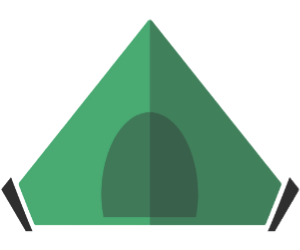
How to choose a backpack for your outdoor trip?
It seems an innocent question, but for enthusiasts who know their thing, it is an inquiry that must be answered.
A good backpack can help ease your adventure. It lets you carry your essentials without becoming a burden. I've heard people complain that their packs are too heavy or bulky, and that's a predicament that you should avoid at all costs.
Fortunately, there are a number of ergonomic and fully functional backpacks in the market today that you can use for camping, backpacking, hiking, and anything in between. If you are choosing one, the general guidelines can certainly help you narrow your choices.
Whenever you are buying a backpack, you should take the following features into account.
If you are heading on a trip that will take several days (probably more than a week), you would need a large backpack. It is a requirement, especially during winter or high-altitude hikes. With a bigger pack, you will be able to bring more clothes, a better sleeping bag, and a large tent. But of course, these backpacks are also ideal for family camping, especially if you are bringing your children with you. Parents just don't want their little ones to carry the heavy stuff.
For most outdoor adventures, multi-day backpacks are already adequate. They work well for 3-season trips (summer, spring, and fall) that don't last for more than a week. But you can also bring these packs on short excursions, especially if you need to bring a lot of utilities for that trip.
If you usually go on an outdoor adventure during the weekends, these weekend backpacks are the best choice for you. They can carry items that can help you last up to nights. They are also a suitable option for weight-conscious backpackers. You should learn about light packing first before you can fully optimize the capacity of these weekend backpacks.
The frame of the backpack serves as its backbone. A properly designed frame helps in weight management as well as capacity optimization. But keep in mind that there are backpacks that don't even have frames!
I am pretty sure that you experienced a certain feeling of uncomfortable warmth when carrying a backpack. It is an indicator that the backpack doesn't have sufficient ventilation to aid in optimizing the air circulation in your back. The ideal backpack should have a mesh layer to wick off sweat. Meanwhile, other backpacks have vents or chimneys on them to deal with the same problem.
Most of the backpacks today have access points on their top. That's the standard design. After all, accessing a pack on its back or sides is quite impractical and difficult. Other backpacks have panel access to their various parts, allowing you to open the bag to get your things without opening the top. However, such a design is only available for slightly expensive options. To overcome this problem, you might want to unload your backpack and get your essentials upon reaching your destination. You could also put the most important ones on the top so that you can take them easily.
There's a lot of options when it comes to backpack storage. Some people prefer having a backpack with multiple pockets. Others want to keep the numbers to a minimum. Of course, preference matters, but it would be great if you can know the types of pockets that are equipped in backpacks.
A backpack should have a sufficient defense against the elements. Rain and snow may appear the least you expect, so you might want your backpack to fend off these elements. A backpack that has water-resistance or waterproofing capabilities is a great choice here. Despite the presence of these features, this doesn't mean that water can't breach through the zippers and seams of the backpack.
An excellent way to deal with this issue is to waterproof the items inside the backpack. You can do this by stashing them in waterproof stuff sacks.
Padding is an essential aspect of backpacks. Those with minimal pads on their lumbar and hip belt region can cause their users to experience painful shoulders and lower back. But of course, the effectiveness of padding depends on the fit of the backpack. If it is too big or too low for you, a well-padded backpack may be rendered useless.
The fit of the backpack is a significant consideration in choosing a backpack. Specifically, the pack should correspond to the length of your torso and the circumference of your hip.
Most backpacks today are available in different sizes--from the extra-large units to the smaller ones. One of these sizes can fit your torso length. Of course, manufacturers don't follow the same sizing chart, so it is essential that you can check the labels to see the correct figures. There are also sizes intended for the female body. You should also check backpacks that come with adjustable suspension; such a feature enables the pack to respond to your torso size. However, keep in mind that the harness contributes to the weight of the backpack.
Your hips handle a significant chunk of the weight of a backpack. Most belts can cater to a plethora of waist circumferences--starting from 20 inches up to 40 inches or bigger. If you have a small or narrow hip, you'll not easily find a hip belt that can fit your needs. At this point, you might want to go for a smaller pack to find a snug hip belt.
Learning how to choose a backpack is essential. After all, a backpack helps you accomplish every outdoor endeavor as comfortably and securely as possible. Regardless of your pursuit, you need a pack that has the right fit, capacity, and features. In this way, you'll be able to head out without having any qualms.
That's it for now. If you have other related inquiries, feel free to ask me in the comment section below.